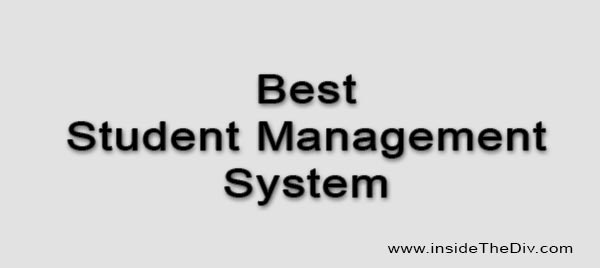Best Student Management System Examples
Last Updated: 2022-12-25 10:54:17
A student management system is a software application or platform that is designed to manage various aspects of a school or educational institution, such as student enrollment, schedules, grades, and attendance.
Student Management System Examples
Here are 10 examples of student management systems that are commonly used in schools and educational institutions.
- PowerSchool: This cloud-based student information system offers a range of features, including student registration, attendance tracking, grading, and communication tools. It also has a parent portal for accessing student information and a mobile app for on-the-go access.
- Blackbaud: This comprehensive student management platform includes student records, communication tools, and fundraising capabilities, as well as a range of reporting and analytics tools. It also has a parent portal for accessing student information.
- Skyward: This student management system provides tools for scheduling, grading, and reporting, as well as a parent portal for communication and access to student information. It also offers a mobile app for on-the-go access.
- SchoolMaster: This student information system includes features such as student enrollment, class schedules, and grading tools. It also offers a range of reporting and analytics tools.
- Illuminate: This student management system offers a range of tools for student assessment, data analysis, and communication with parents and teachers. It also has a parent portal for accessing student information.
- Aeries: This cloud-based student information system allows for student registration, attendance tracking, and grading, as well as parent and teacher portals for communication and access to student information. It also offers a range of reporting and analytics tools.
- Rediker: This student management system includes features such as student records, communication tools, and a parent portal for accessing student information. It also offers a range of reporting and analytics tools.
- SchoolMint: This student enrollment and registration platform allow for the collection and management of student data. It also offers a range of communication and reporting tools.
- CampusVue: This student management system offers a range of tools for student enrollment, class schedules, and grading, as well as a parent portal for communication and access to student information. It also includes a range of reporting and analytics tools.
- Jenzabar: This comprehensive student management platform includes features such as student records, communication tools, and a parent portal for accessing student information. It also offers a range of reporting and analytics tools.
You can also create a simple student management system using the c programming language.
Common Student Management System features with example
Every student management system has some common features based on its Objectives, Scope, Requirements, Budget, and Quality control. Here we will see 10 common features has most Student Management Systems.
Student enrollment
This feature allows for the collection and management of student data, including personal and academic information. For example, a student management system might allow administrators to enter a new student's name, address, and contact information, as well as their previous academic history and any special needs or accommodations.
Class scheduling:
This feature allows for the creation and management of class schedules, including the assignment of students to specific classes and teachers. For example, a student management system might allow teachers to create a schedule for their classes, including the days of the week and times that the classes meet. It might also allow administrators to assign students to specific classes based on their schedules and academic needs.
Attendance tracking
This feature allows for the tracking of student attendance, including the recording of absences and tardies. For example, a student management system might allow teachers to mark students as present or absent for each class period, and generate reports on attendance patterns over time.
Grading
This feature allows teachers to enter and manage grades for assignments and tests, and calculate overall grades for each student. For example, a student management system might allow a teacher to enter grades for each assignment and test, and calculate a student's overall grade for the semester based on the weighted average of these grades. It might also allow students to view their grades and progress online.
Student records
This feature allows for the storage and organization of student records, including transcripts, test scores, and other important documents. For example, a student management system might allow administrators to upload and store copies of student transcripts, test scores, and other important documents, and allow authorized personnel to access and update these records as needed.
Communication tools
This feature provides a platform for teachers and parents to communicate with each other and with students, for example by sending announcements or sharing resources. For example, a student management system might allow teachers to send announcements or assignments to their students via email or through a messaging system within the platform. It might also allow parents to view their child's progress and contact the school or teachers through a parent portal.
Parent Portal
This feature allows parents to access their child's academic information and communicate with teachers and school administrators. For example, a student management system might provide a parent portal that allows parents to view their child's grades, attendance, and other important information. It might also allow them to communicate with teachers or school administrators through a messaging system or email.
Mobile app
A mobile app provides students and parents with on-the-go access to their schedules, grades, and other important information. For example, a student management system might offer a mobile app that allows students to view their class schedules and assignments, as well as check their grades and attendance records, from their phone or tablet.
Reporting and analytics
This feature provides a range of tools for generating reports and analyzing data, such as attendance patterns and student performance. For example, a student management system might allow administrators to generate reports on attendance patterns, grades, and other data, and use these reports to identify trends and areas for improvement.
Customization
This feature allows administrators to customize the system to meet the specific needs of their school or institution. For example, a student management system might allow administrators to add or modify fields in student records, create custom reports, or customize the user interface to meet the needs of their school or district. It might also allow for the integration of other systems or tools, such as a school's website or learning management system.
Some general instructions for using a student management system
A student management system is a software application or platform that is designed to manage various aspects of a school or educational institution, such as student enrollment, schedules, grades, and attendance. Here are some general instructions for using a student management system:
- Register and set up an account: Depending on the system you are using, you may need to register for an account and set up your user profile. This may include providing personal and contact information, as well as selecting a username and password.
- Enter student data: If you are an administrator, you may be responsible for entering student data into the system, including personal and academic information. This may include information such as name, address, contact information, previous academic history, and any special needs or accommodations.
- Set up class schedules: If you are a teacher or administrator, you may be responsible for setting up class schedules and assigning students to specific classes and teachers. This may involve creating a schedule for your own classes or assigning students to the classes of other teachers.
- Record attendance: Teachers can use the system to record student attendance, including marking students as present or absent for each class period.
- Enter and manage grades: Teachers can use the system to enter and manage grades for assignments and tests and calculate overall grades for each student. Students can use the system to view their grades and progress.
- Communicate with students and parents: The system may provide a platform for teachers to communicate with students and parents, for example by sending announcements or sharing resources. Parents may also be able to view their child's progress and contact the school or teachers through the system.
- Access and update student records: The system should allow authorized personnel to access and update student records, such as transcripts, test scores, and other important documents.
- Use reporting and analytics tools: The system may provide a range of tools for generating reports and analyzing data, such as attendance patterns and student performance. This can be useful for identifying trends and areas for improvement.
- Use a mobile app (if available): Some student management systems offer a mobile app that allows students and parents to access their schedules, grades, and other important information on their phones or tablet.
- Customize the system: Depending on the system you are using, you may have the ability to customize certain aspects of the system to meet the specific needs of your school or institution. This may include the ability to add or modify fields in student records, create custom reports, or customize the user interface.
If you want to learn how to create a student management system you can create a simple student management system using the c programming language.
Still you face problems, feel free to contact with me, I will try my best to help you.

